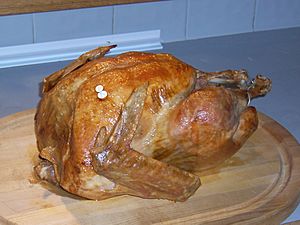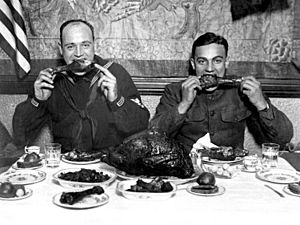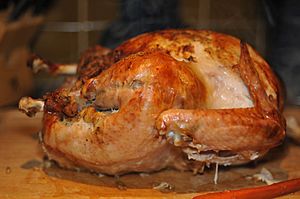Turkey as food facts for kids

Turkey meat, often just called turkey, is the meat that comes from turkeys. Most of the time, this is from farm-raised turkeys, but it can also be from wild turkeys. It's a very popular type of poultry (bird meat), especially in North America. People often eat turkey during special holidays like Thanksgiving and Christmas. It's also a common food in everyday meals.
Contents
How Turkey is Prepared and Sold
You can buy turkeys in different ways. They are sold sliced, ground up, or as a "whole" bird. A whole turkey is like a whole chicken, with its head, feet, and feathers removed. Many people still buy whole turkeys that are frozen.
Sliced turkey is often used in sandwiches or as cold cuts. If a recipe asks for chicken, you can often use turkey instead. Ground turkey is also popular and is often seen as a healthier choice than ground beef. When you cook turkey, it can sometimes be less juicy than other meats like chicken or duck if not prepared carefully.
Wild turkeys taste very different from farm-raised turkeys. Almost all the meat from a wild turkey is "dark meat," even the breast. It has a stronger flavor. The taste can also change depending on what the wild turkey has been eating. For example, if it eats more insects, its meat might taste more "gamey." If it eats mostly grass and grain, it will have a milder flavor.
A lot of turkey meat is processed. This means it's changed in some way. It can be smoked and sold as turkey ham or turkey bacon. Many people think these are healthier than pork bacon. In the UK, a deep-fried turkey product called "turkey twizzlers" became well-known in 2004. Chef Jamie Oliver worked to have these kinds of foods removed from school dinners.
Unlike chicken eggs, turkey eggs are not usually sold for eating. This is because there's a very high demand for whole turkeys for meat. Also, turkeys don't lay as many eggs as chickens, ducks, or quail. One turkey egg can be worth about $3.50, which is much more than a whole carton of chicken eggs!
Turkey in Cultural Traditions

Turkeys are a traditional main dish for Thanksgiving dinner in the United States and Canada. They are also a popular choice for Christmas dinner in many other parts of the world. Often, the turkey is stuffed with other ingredients.
People in Mexico, Central America, and the southern United States have eaten turkey for a very long time. In the 15th century, Spanish explorers brought Aztec turkeys back to Europe.
Turkey was eaten in England as early as the 16th century. Before the 1900s, pork ribs were actually more common for North American holidays. This was because pigs were usually butchered in November. Wild turkeys were once so common that people ate them all year round. Pork ribs, however, were rarely available outside of the Thanksgiving and New Year season. While eating turkey for Christmas became popular in Britain in the 1600s, many working-class families ate goose instead. Goose remained the most popular roast until the Victorian era.
Turkey with mole sauce is considered the "national dish" of Mexico.
Cooking Turkey
Both fresh and frozen turkeys are used for cooking. Fresh turkeys are often preferred, but they cost more. Around holidays, it can be hard to buy fresh turkeys without ordering them early. Frozen turkeys are usually very large, so defrosting them takes a long time. A typical turkey can take several days to thaw completely.
Turkeys are usually baked or roasted in an oven for a few hours. Sometimes, a turkey is brined (soaked in salty water) before roasting. This helps to make it more flavorful and juicy. Brining is helpful because the dark meat needs to be cooked at a higher temperature than the white meat. If you cook the dark meat until it's done, the breast (white meat) can become dry. Brining helps keep the breast meat juicy while the dark meat cooks fully.
In some areas, especially the American South, turkeys are also deep fried in hot oil. This takes about 30 to 45 minutes using a special turkey fryer. Deep frying turkey has become popular, but it requires great care because of the large amounts of hot oil involved.
Nutrition Facts
When raw, turkey breast meat is mostly water (74%), with a good amount of protein (25%) and a small amount of fat (1%). It has no carbohydrates. A 100-gram serving of turkey breast provides energy and is high in protein, niacin, vitamin B6, and phosphorus. It also has a moderate amount of pantothenic acid and zinc.
Turkey breast contains an amino acid called tryptophan. Some people think that the tryptophan in turkey makes you feel sleepy after a meal. However, there is no scientific proof that the amount of tryptophan in turkey meat causes you to feel drowsy.
| Meat | Protein (per 100 g) |
|---|---|
| Salami | 13.0 g |
| Pork sausages (grilled) | 13.3 g |
| Ground beef | 23.1 g |
| Roast chicken | 24.8 g |
| Grilled lean, back bacon | 25.3 g |
| Roast turkey | 25.0 g |
What to Eat with Turkey
For Thanksgiving in the United States, turkey is traditionally served with cranberry sauce and gravy. It's often stuffed or has dressing (cooked separately) on the side. Other common dishes include mashed potatoes, corn on the cob, green beans, squash, and sweet potatoes. For dessert, pie is common, especially pumpkin, apple, or pecan pie.
For Christmas in the United Kingdom, turkey is traditionally served with winter vegetables. These include roast potatoes, Brussels sprouts, and parsnips. Cranberry sauce is popular, especially where wild cranberries grow. In other areas, bread sauce was used, but cranberry sauce is now more common. Sometimes, small sausages or liver wrapped in bacon (called "pigs in blankets") are also served.
Especially during holiday seasons like Thanksgiving and Christmas, stuffing or dressing is traditionally served with turkey. There are many kinds of stuffing, including oatmeal, chestnut, sage and onion (made with flavored bread), cornbread, and sausage stuffing. Stuffing can be put inside the turkey or cooked separately as a side dish.




